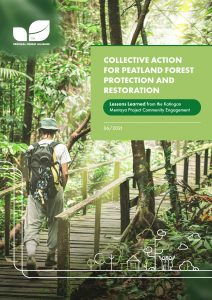Restoring the Ecosystem
Threats to Peatland
The conversion and degradation of peatland ecosystems threatens biodiversity, increases the risk of fires, increases carbon emissions, reduces soil quality, and can have a negative impact on local community wellbeing and livelihoods.
The drivers of peatland forest conversion and degradation are complex and varied, and include the expansion of oil palm plantations, the development of industrial timber forests (Hutan Tanaman Industri/HTI); the expansion of food stock agriculture; illegal logging; land and forest encroachment; forest fires; mining activities; and land banking.
A Brief History of Key Developments
Mischief of peat ecosystem due to conversion and degradation is causing degradation of biodiversity, an increase of carbon emission, the reduction of soil quality and disruption of local community livelihood, up until social conflict. This mischief is caused by expansion of oil palm plantation, the development of Industrial Timber Forest (Hutan Tanaman Industri/HTI), expansion of food stock agriculture, illegal logging, land and forest encroachment, forest fire, mining activity, and land banking.
The initiative of Green House Gas (GHG) Emission reduction had been going on globally. This initiative was taken as an improvement on the current global condition that is being threatened by global warming and climate change. The Kyoto Protocol in 1997 establishes the Clean Development Mechanism (CDM), a United Nations-run carbon offset scheme. Indonesia ratifies the Kyoto Protocol via government act number 17/2004 as a follow-up and a basic reference for policies related to climate change that ruled in act number 6/1994.
